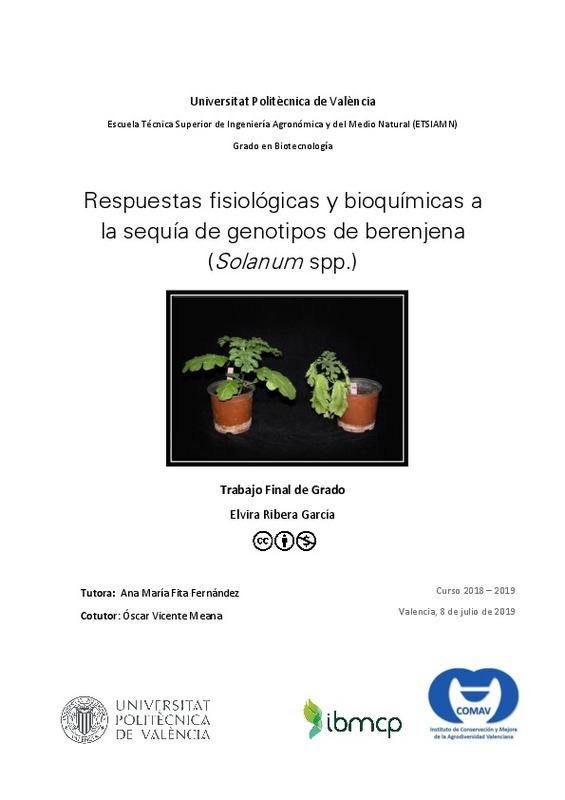|
Resumen:
|
[ES] Como consecuencia del cambio climático, la sequía y la salinidad del suelo están
aumentando. Estos factores son responsables de pérdidas muy importantes en la producción
agrícola mundial, por lo que el aumento de ...[+]
[ES] Como consecuencia del cambio climático, la sequía y la salinidad del suelo están
aumentando. Estos factores son responsables de pérdidas muy importantes en la producción
agrícola mundial, por lo que el aumento de la tolerancia a sequía y salinidad en nuestros cultivos
se ha convertido en una necesidad urgente.
Aunque los principales cultivos utilizados sean relativamente sensibles al estrés hídrico y salino,
existe una enorme variabilidad genética en las especies silvestres que puede ser utilizada para
mejorar dichos cultivos. En este estudio en concreto, se ha analizado la respuesta a la sequía de
nueve genotipos de Solanum spp., con el fin de evaluar su potencial para mejorar la tolerancia
al estrés hídrico de la berenjena cultivada (Solanum melongena). Los genotipos que evaluar son
una serie de parientes silvestres de la berenjena (S. insanum, S. incanum, S. linnaeanum y S.
dasyphyllum). También se ha analizado la respuesta de algunos híbridos de S. melongena con S.
insanum y S. incanum.
Con este objetivo, se han realizado dos tratamientos; sequía, que consistió en la eliminación
total de riego, y un tratamiento control. La evolución del crecimiento de las plantas ha sido
analizada mediante diferentes parámetros morfológicos. Además, se han evaluado algunos
mecanismos de tolerancia mediante el análisis de marcadores bioquímicos asociados al estrés
abiótico: prolina, flavonoides y compuestos fenólicos totales. También se ha estimado el nivel
de estrés oxidativo cuantificando el contenido en malondialdehído (MDA).
Como resultado, el tratamiento de sequía tuvo un gran efecto sobre el crecimiento de las plantas
y el contenido en agua de los tejidos. Generalmente, el estrés aumentó significativamente el
contenido en MDA, prolina, flavonoides y compuestos fenólicos totales, aunque se han
observado diferencias cuantitativas entre especies. Concretamente, S. dasyphyllum y una de las
accesiones de S. insanum mostraron una mayor tolerancia a la sequía: INS1 destaca por ser la
accesión con menor pérdida de agua y DAS1 por la mayor capacidad de generación de biomasa
en condiciones de sequía. El híbrido INC1 x MEL1 se constituyó también como buen candidato
para la introgresión de genes en S. melongena, al obtener mejor respuesta a la sequía que los
otros híbridos evaluados y que sus propios parentales. Los resultados aquí obtenidos respecto a
la tolerancia de las especies pueden ser de utilidad para diseñar futuros proyectos que aborden
la mejora genética de la berenjena cultivada.
[-]
[EN] As a result of climate change, drought and salinity are increasing in the soil. These
factors are the origin of the major decrease regarding the agricultural yield. For this reason,
plants tolerance to drought and ...[+]
[EN] As a result of climate change, drought and salinity are increasing in the soil. These
factors are the origin of the major decrease regarding the agricultural yield. For this reason,
plants tolerance to drought and salinity must be urgently improved.
Although main crops are relatively sensitive to water stress and salt stress, there is high genetic
diversity in wild plants that can be used for the improvement of our crops. In this study, the
response to drought of nine accessions of Solanum spp. was assessed with the aim of finding
interesting features for the improvement of eggplant tolerance to water stress. The genotypes
are a set of wild plants related to the eggplant (S. insanum S. incanum S. linnaeanum y S.
dasyphyllum). Interespecific hybrids of S. melongena with these species. Interspecific hybrids
between S. melongena and S. insanum y S. incanum were also assessed.
The plants were subjected to two treatments: control and drought, and during this process,
morphological attributes were evaluated. Furthermore, the physiological and biochemical
response will be analyzed by using stress biomarkers as proline, flavonoids and total phenolic
compounds. Oxidative stress was quantified by measuring malondialdehyde (MDA) content.
In consequence of the drastic treatment, plant development and tissue water content were
seriously affected. Generally, water deficit also caused significant increases in MDA, proline,
flavonoids and total phenolics compounds. Our results show a better response to drought in the
case of S. dasyphyllum and one of the accessions of S. insanum. S. dasyphyllum is capable of
generating biomass properly despite the water deficit. S. insanum presents the smaller water
loss. The hybrid between S. melongena and S. incanum showed a better response than the other
hybrids and even than its parents.
The results obtained here might be useful for future eggplant breeding programmes with the
aim of drought tolerance improvement.
[-]
|





![PDF file [Pdf]](/themes/UPV/images/pdf.png)


